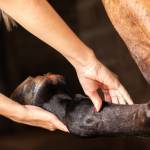Do Aging Stem Cells Have Limited Utility in Equine Injuries?

Stem cells show a decline in their ability to differentiate into cartilage and bone cells as they age, potentially leaving older horses in the lurch when it comes to biological therapy, according to researchers.
In the study, researchers collected stem cells from bone marrow and adipose tissue from newborn foals, yearlings, young adults, middle-aged horses, and geriatrics.* Those cells were cultured in the laboratory and then induced to differentiate into cartilage and bone cells (chondrocytes and osteocytes, respectively).
To determine how many of the stem cells differentiate into chondrocytes, researchers measured proteoglycans produced by cartilage cells, the bone-specific enzyme alkaline phosphatase, and calcium deposition. Various genes indicative of cartilage and bone function were also measured. These test results were compared between the different age groups.
Adipose-derived stem cells had minimal ability to differentiate into cartilage cells, but bone marrow stem cells could become cartilage. Both cell types were able to differentiate into bone cells. Regardless of the stem cell source, their ability to differentiate declined significantly with increasing age of the donor.
“The diminishing ability for bone marrow-derived stem cells to turn into chondrocytes and osteocytes was observed in samples taken between birth and one year of age,” explained Kathleen Crandell, Ph.D., a nutritionist for Kentucky Equine Research. “Because stem cell therapies are generally used in horses beyond the neonate and yearling phases, donor age could prove to be an important determinant when considering the use of this regenerative therapy.”
Orthobiologics—biological therapies, such as stem cells, used to help musculoskeletal injuries heal—are now considered commonplace in therapeutic settings. How exactly stem cells facilitate the healing processes remain unclear, however.
“This study suggests that ‘aged’ donor cells may not be the most functional. This could lend credence to banking stem cells from the umbilical cords of foals at the time of birth,” Crandell suggested.
Rather than waiting for injury to strike, offering athletic horses joint supplements prophylactically helps protect the delicate lining of cartilage within joints from inflammation and damage.
“Look for joint supplements with ingredients like glucosamine hydrochloride, chondroitin sulfate, and hyaluronic acid for maintaining joint integrity, reducing cartilage damage, and stimulating cartilage repair,” Crandell advised.
Once the inflammatory cascade within a joint is initiated, osteoarthritis develops rapidly, which over time can negatively affect both performance and quality of life.
*Bagge, J., L.C. Berg, J. Janes, and J.N. MacLeod. 2022. Donor age effects on in vitro chondrogenic and osteogenic differentiation performance of equine bone marrow- and adipose tissue-derived mesenchymal stromal cells. BMC Veterinary Research 18(1):388.








